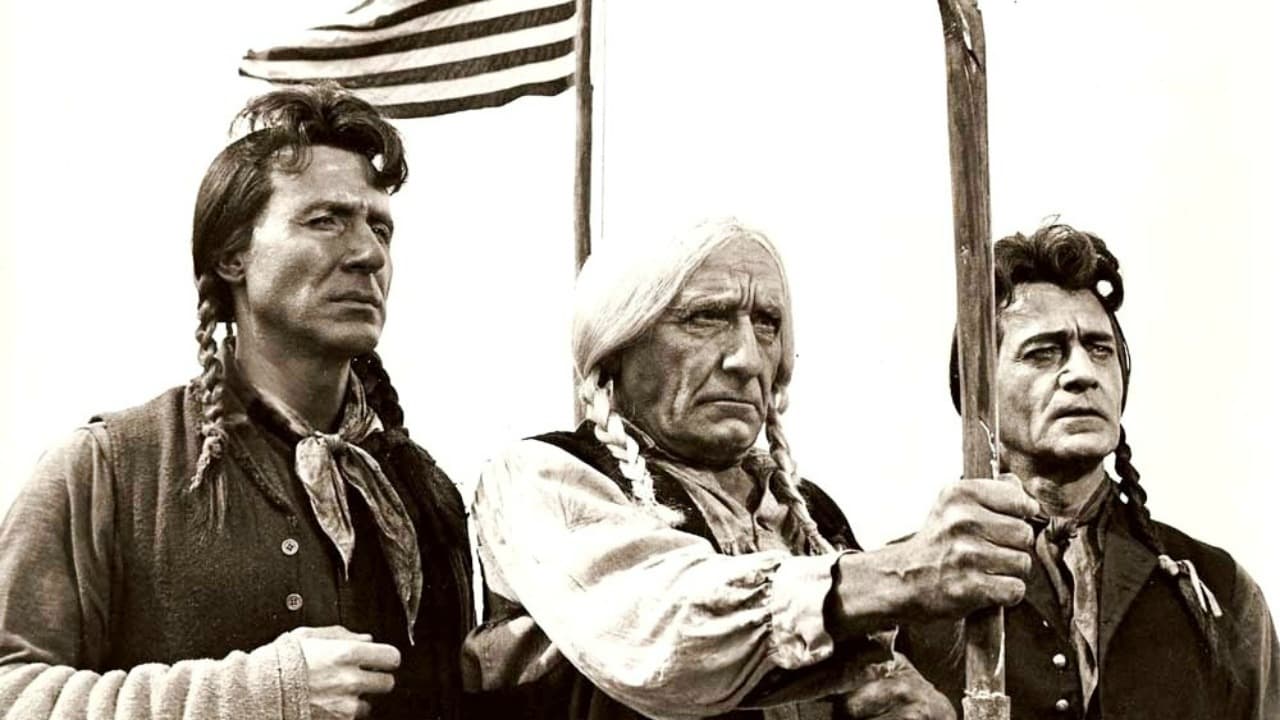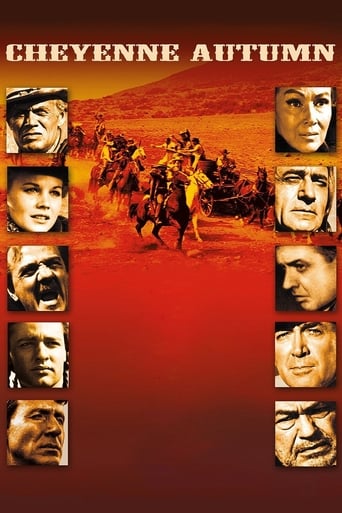

This may be John Ford's worse movie. Weak script. Mediocre acting. Miscast.
... View MoreCheyenne Autumn was intended as the big-budget western release of 1964, the follow-up to How the West Was Won with several of the same cast members and one of that film's directors. For a movie made in 1963, the theme is a bold one about the White man's ill-treatment of the Cheyenne (actually the North Cheyenne tribe) and their 1878 journey back north to their homeland.Unfortunately, the film is a mess and for a movie made by a top 'A' director, it is surprisingly incompetently directed. Some comments:the Dodge City sequence. I would have liked to see this expanded to a feature length film and released separately. It is very funny. However, it doesn't belong in this film. What was Ford smoking when he put this in? Karl Malden's prototype Nazi officer who has "Orders, orders zat must be OBEYED". "I HAF ORDERS". Malden seems to think he is auditioning for John Cleese's role in The Germans episode of Fawlty Towers. Couldn't someone keep him under control? And what about that huge pipe he pulls out of his coat at one point and then exits stage left after blowing out the sergeant's offered match? That made me laugh. A touch worthy of Peter Sellers. One can see the point being made but the execution is ridiculous. It was also amusing to see the German name of Edward G Robinson's character being downplayed presumably because the writers had forgotten that one of the major 'good guys' was also of German ancestry when they created the Nazi character. (interesting historical footnote - the real Carl Schurz spoke with a thick German accent whereas the real Cpt Wessels was born in New York and likely didn't - he certainly was never a Prussian officer) in the first encounter between the cavalry and the Indians, Richard Widmark is summarily court martialled and put under arrest for reasons not apparent to this viewer (was something cut out?). Later Widmark goes up to a soldier and asks where the major is only for the soldier to point to a body which is virtually lying at Widmark's feet being attended to by a physician. This is like something out of The Naked Gun. I had to rewind here to check I hadn't missed anything as it looked so stupid.the second skirmish with the Indians is appallingly choreographed and edited. After establishing that we are in some kind of shrub/semi-desert area, when Pat Wayne leads a cavalry charge, the cavalry are shown charging over some flat sandy area which is obviously a completely different location. Then, the Indians set fire to a few fake-looking shrubs and about five seconds later, the cavalry's wagons and cannon are enveloped in flames despite being at least several hundred yards away. Richard Widmark and the rest of his command appear to be doing nothing whilst this happens although Wayne's men seem to be close enough for Widmark to be shouting at them. A quick cut and Widmark is personally helping save the cannon - what has happened to the hundred odd men in his command. Why aren't they helping? Who knows.Ricardo Montalban and Gilbert Roland's mullets. Very silly and must have given the set hairdresser lots of chuckles. Didn't anyone look at any pictures of the real Dull Knife and Little Wolf? Still, at least even they don't look as ridiculous as Sal Mineo.Surely someone must have realised that it sounded stupid to constantly refer to a major character as "Spanish Woman" rather than give her a proper name? There is no excuse for this as it's not even a real historical name.What did make me laugh was that most of the time it looked as if Little Wolf and Dull Knife's orders to the tribe were having to be translated for them by the elderly unnamed Cheyenne who was standing next to them in many scenes and was a real Indian (a senior Navajo I'm guessing). Almost every time they said something in Cheyenne, this guy would then turn round and repeat it to the other Indians. This again looked ridiculous Matters being brought to what seemed a premature conclusion by Edward G Robinson standing infront of an appallingly unconvincing piece of back-projection, not even pointed in the right direction, and mouthing a few platitudes. Had the money run out at this point? (the Robinson scene is completely fictitious by the way).In short, worthy in intent but incompetent in execution and in places mind-numbingly bad for an expensive film made by a talented director.
... View MoreHistorical and overlong movie recounting the legendary Cheyenne trek led by the Indian chiefs , Little Wolf and Dull Knife . The picture is an epic portrait of the historic story about celebrated Cheyenne (they are actually Navajo, telling dirty jokes in their native tongue) and their legendary feat leading the tribe on a journey to freedom , uprooting them from the Yellowstone and resettling them in distant Oklahoma . This majestic flick illustrates the callous disregard with which the government treated the Cheyenne in the 1880s as the US agency fails to deliver even the meager provisions due by peace treaty to the stubborn tribe in their stark desert reserve without proper supplies for survival ; then the starving Indians have taken more abuse than it's worth and break it too by embarking on a 1,500 miles trek back to their ancestral hunting grounds , being led by Little Wolf and Dull Knife (Ford was urged to cast Richard Boone and Anthony Quinn , as both had Native American blood ; Ricardo Montalban and Gilbert Roland, who were of Mexican descent, were cast instead) . Meanwhile , proud Cheyenne tribe square off US cavalry commanded by Thomas Archer (Richard Widmark) who leads his army on a wild chase across the barren plains in this saga of the old west . Red Shirt (Sal Mineo , John Ford would not allow Sal to speak any English dialog in the movie due to the actor's Bronx accent) , a rebel Indian does the first shot against cavalry . Captain Thomas Archer goes to deal with Secretary of Interior Schulz about the unfortunate Indians (Spencer Tracy was first cast as the secretary of interior Karl Shultz, but had a heart attack and was replaced by Edward G. Robinson, whose scenes were entirely photographed in studios, including the climatic meeting scene between Shultz and the Cheyenne chiefs, in which the background had to be done with screen process). The tribe refuses to surrender in this chronicle of a bitter fight between the tribe and the US cavalry in the struggle for the west.This sprawling epic film displays action Western , shootouts , drama and spectacular battles . It's a thoughtful piece for its time that had an original tragic ending and imbued with moments of sensitive poetry . This nice Western contains interesting characters , full of wide open space and dramatic moments . This classic , sturdy picture ranks as one of the most sentimental of John Ford's work .Thought-provoking , enjoyable screenplay portraying in depth characters and brooding events with interesting issues running beneath script surface and suggested by Mari Sandoz in "Cheyenne Autumn¨ with screenplay by James R. Webb and based on a novel titled Last Frontier by Howard Fast who also wrote Spartacus . This excellent film featuring a magnificent performance by whole casting , including a top-notch support cast . Awesome Richard Widmark in a larger-than-life character along with a gorgeous Carrol Baker and a magnificent Karl Malden as deranged captain Wessels . In the film appears , as usual , Ford's favourite actors as Ben Johnson , Harry Carey Jr , Mike Mazurki , George O'Brien , Mae Marsh , Patrick Wayne , Dolores Del Rio , Ken Curtis , Elizabeh Allen , Willis Bouchey , and of course James Stewart as obstinate sheriff Earp . Ford added the segment with Stewart in place of an intermission , he didn't want people leaving the auditorium to go the bathroom or concessions counter, even though the film was long, and so he came up with the Wyatt Earp segment ; Ford later quipped to Stewart that the actor was the "best intermission" in the movies . Outdoors are pretty good and well photographed in Super Panavision 70mm by William H Clothier and filmed on location in Moab, Utah,Fort Laramie, Wyoming, Monument Valley, Utah , Gunnison Canyon, Colorado . Rousing and an impressive musical score by Alex North who composed other masterpieces as Spartacus and Cleopatra.This may not be Ford's best Western , as many would claim , but it's still head ad shoulders above most big-scale movies .You'll find the ending over-dramatic according to your tastes , though it's lovingly composed by John Ford who really picks up battle , drama and sensibility towards the ending . Rating : Better than average , worthwhile watching . The motion picture well produced by Bernard Smith was brilliantly directed by John Ford at his last film . This powerful movie will appeal to Indian Western fans
... View MoreCheyenne Autumn is directed by John Ford and is a "Hollywood" telling of the Northern Cheyenne Exodus of 1877/9, where the Northern Cheyenne, fed up with lack of food and poor facilities, tried to return to their one time home in the North after having been located in the Southern Reservation by the United States Army. It stars Richard Widmark, Caroll Baker, Dolores del Rio, Karl Malden, Gilbert Roland, Ricardo Montalban, Edward G. Robinson, James Stewart and Arthur Kennedy. Music is scored by Alex North and cinematography by William H. Clothier. It is photographed in Super Panavision 70, in various Utah locations, predominantly Monument Valley.Does it ever matter who fired the first shot?John "Pappy" Ford's penultimate film, and his last Western, is epic in scope and production and seen as an honest attempt to redress the balance for years of misrepresentation of Native Americans in Hollywood, though not necessarily his own since he, I believe, isn't on record as saying that to be the case? Thematically it's important and doesn't back off from being sympathetic to the Cheyenne's plight, we root for them and rightly so. Yet it always feels like a film shot through the vision of a white man's eyes, you find yourself wanting more from the Cheyenne perspective, for them to dominate the narrative. It would have been nice to know some of the big players involved in the heroic and tragic trek back to Wyoming. It's also annoying that Ford or the studio chose to interrupt the flow of the story with the pointless light relief section at Dodge City. Which comes across as just an excuse for James Stewart and Arthur Kennedy to play Wyatt Earp & Doc Holliday respectively. And sadly, they are not very successful in doing so either.As has been noted by many critics over the years, the film ultimately rounds out as an honourable misfire from the great John Ford. The cast, away from the loud and brash Dodge City collective, are mostly fine. Widmark proves to be a watchable axis as the reluctant Captain tasked with returning the Cheyenne to the barren reservation. Baker does a nice line in sexy Quaker, Robinson adds a touch of class late in the day, while Montalban & Roland are excellent as Cheyenne chiefs Little Wolf & Dull Knife respectively. But all pale in the shadow of Clothier's magnificent photography, stunning vistas that dominate the screen, the colours so rich and splendid, Monument Valley an iconic character of nature observing the Cheyenne desperately trying to get back to home comforts.It's unmistakably a John Ford picture, with some inspired filming techniques, but the heart of the story is lost due to a too long run time, a daft mid point sequence and much extraneous nonsense. 6/10
... View More